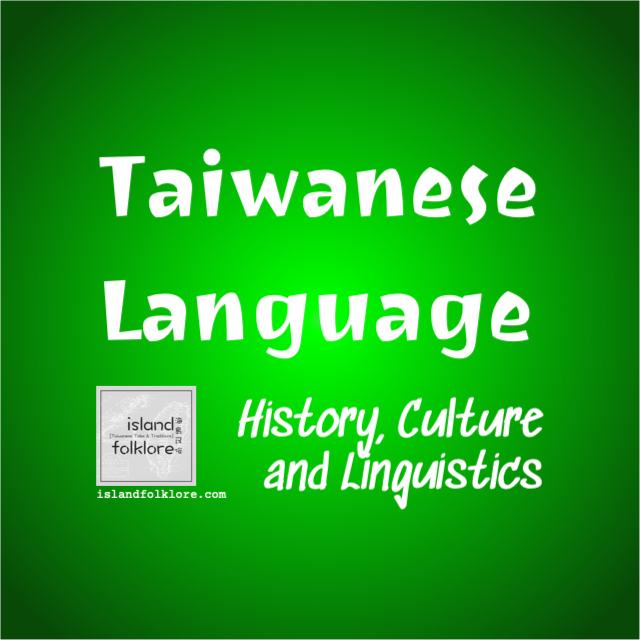The Taiwanese language is traditionally the most widespread of Taiwan’s over 20 languages. Its relation to the more high-profile Mandarin is similar to that of Portuguese to Spanish.
A variety of Hokkien, Taiwanese descends from an ancient line of Min languages. This line diverged from the other Chinese varieties nearly 2,000 years ago.
To borrow the Iberian analogy again, if the Taiwanese language represented Portuguese, Hokkien is rather like the Galician language spoken just across the border in northwestern Spain.
This Taiwanese situation may seem peculiar at first but is actually a very common pattern. Other notable parallels include Dutch-Flemish-German and English-Scots comparisons—the list goes on. Look them up!
The following story is of a bizarre and fascinating writing system—developed in the 1800s—used to write the Taiwanese language.

Unlike other Chinese languages, Hokkien and Taiwanese are written primarily in the Latin alphabet in a system known as vernacular writing or Pe̍h-ōe-jī (POJ).
Promoted by the small yet influential Presbyterian Church in Taiwan, POJ became especially popular there. Notably, the island’s oldest newspaper, the Tâi-oân Kàu-hoē Kong-pò (Taiwan Church News)—in circulation since 1885—continues to feature publications in the Taiwanese language written in the vernacular POJ.

Letters and Sounds: The POJ Advantage
Unlike Chinese writing, which is made up of symbols representing a combination of sounds, ideas and images, POJ is a purely phonetic system that spelled out and preserved the pronunciation of Taiwanese.
While Chinese characters are ideal for preserving the beauty, philosophy and etymology of words and symbols, the phonetic POJ is significantly easier to learn. Instead of memorizing over 2,000 individual Chinese symbols, students need only to know 26 letters plus a few additional diacritical and tonal marks.
POJ made the spread of Taiwanese literacy possible—enabling even the most impoverished to read, write and access higher education.
Thanks to POJ, if you can speak Taiwanese, you can write Taiwanese. Before universal education in Taiwan and the creation of Simplified Chinese in China, the same could not be said for Mandarin and the other Sinitic languages.

Such poetic symbolism is not possible with POJ, but it does possess many other crucial advantages.
The People’s Language
Vernacular refers to the common people’s speech as opposed to the esoteric language of a ruling elite. POJ—Pe̍h-ōe-jī —means vernacular writing and is so-called because it is used to write the people’s language.
Latin, for example, was the language of intellectuals in much of Medieval Europe. The common folk, however, spoke vernacular languages—such as Italian and English—that weren’t written down until much later.
In the Far East in premodern times, a literary language known as Classical Chinese dominated the arts, government bureaucracy, scholarly discourses and international relations.
From Vietnam to Japan, the upper classes communicated using this ancient language. Commoners throughout East Asia, in contrast, spoke a dazzling variety of vernacular languages and dialects. Many of these—for centuries—operated without writing, which was reserved for Classical Chinese.
Today, common Chinese languages like Mandarin and Cantonese have adapted Classical Chinese symbols for modern writing—just as Italian, English and other European languages adapted the Latin alphabet of ancient Rome. Taiwanese and Hokkien, on the other hand, took a different path.
They imported writing from the Christian West.

Early POJ: Hokkien Southeast Asia
Hokkien-speaking communities have existed throughout Southeast Asia for centuries.
Hokkien-speakers (Hoklo people) originate in China’s southeastern province of Fujian, a mountainous place cut off from the rest of China. This enabled Hokkien and other Min languages to develop in relative isolation.
The Hoklo people began settling throughout Southeast Asia in the 1500s. Their diaspora brought them to places like Singapore, Malaysia and Taiwan. The Chinese populations that still live throughout Southeast Asia today are largely descendants of the Hoklo people.
It was there in Hokkien Southeast Asia where the earliest forms of the POJ writing system was born. It began in the 1800s as a Church script devised by Europeans to spread the Christian faith and translate the Bible’s stories.
Eventually, POJ was brought back by converts and missionaries to the Hokkien homeland in southeastern China. It became popular—for a time—among speakers of the Hokkien language there.
In Taiwan, the Presbyterian Church protected and promoted the Taiwanese variety of Hokkien—known as Tâi-oân-oē (Taiwanese speech) or Tâi-gí (the Taiwanese language). POJ was used in publishing Taiwanese writing throughout the island and taught in schoolhouses to Taiwanese children. It was a full-fledged system that anchored the Taiwanese language.
Long after POJ disappeared in China and Southeast Asia, its use lives on in Taiwan.

Japanese replaced Taiwanese and other native languages in schools. Later, Mandarin did the same.
Facing Down Challenges: Kōminka and Guóyǔ
Modern Taiwanese language and writing have encountered two formidable obstacles: Japanese Imperialism and Chinese Nationalism.
Under the kōminka policy, Japan tried to assimilate the Taiwanese by making Japanese the standard language of Taiwan. After Japan lost WWII, the Chinese Nationalist regime that took over the governance of Taiwan did the same with Mandarin—calling it guóyǔ (the state language) in Taiwan.
The use of the Taiwanese language was brutally suppressed under both regimes.
With the rise of Taiwanese democracy in the 1970s and 1980s, efforts have been made to embrace and preserve the Taiwanese heritage.
We hope that the efforts of those like the Taiwanese Presbyterians and Taiwanese-language strongholds in the south will see success in preserving this unique linguistic heritage of Taiwan.

Taiwantaffy [CC BY-SA]
See Also: Our Hakka Trilogy!
Taiwan’s Formosan-speaking indigenous nations have always dominated the island’s mountainous highlands in the east. The western lowlands, on the other hand, are home to Taiwan’s two traditional Sinitic groups—the Taiwanese-speakers and Hakkas.
Check out our three-part series on Taiwan’s Hakka heritage!
From a heartbreaking hill song that recorded Hakka frustration with Taiwan, to memories of martyrs who defended Taiwanese Hakka communities, to a modern Hakka revival in Taiwan—find out how an often-disadvantaged people became an integral part of Taiwanese culture, identity and society!




